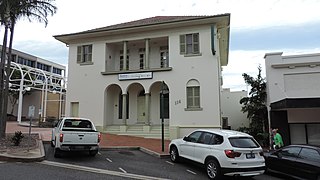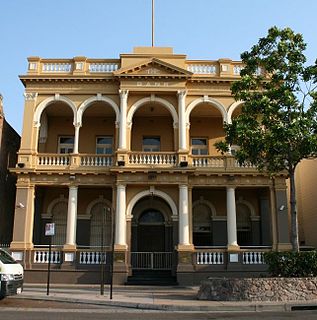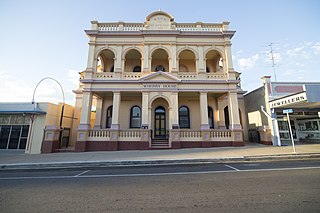
Exchange Hotel is a heritage-listed hotel at 134-138 Patrick Street, Laidley, Lockyer Valley Region, Queensland, Australia. It was designed by Eaton & Bates and built in 1902. It was added to the Queensland Heritage Register on 21 October 1992.

Royal Bank of Queensland is a heritage-listed former bank at 297 Kent Street, Maryborough, Fraser Coast Region, Queensland, Australia. It was designed by Victor Emmanuel Carandini and built from 1888 to 1889. It is also known as Queensland International Heritage College and Windsor House. It was added to the Queensland Heritage Register on 21 October 1992.

Commercial Bank of Sydney is a heritage-listed former bank building at 191–193 Bourbong Street, Bundaberg Central, Bundaberg, Bundaberg Region, Queensland, Australia. It was designed by George Allen Mansfield and built in 1891. It is also known as the National Australia Bank. It was added to the Queensland Heritage Register on 21 October 1992.

Commonwealth Bank Building is a heritage-listed former bank building at 114 Goondoon Street, Gladstone, Gladstone Region, Queensland, Australia. It was built from 1928 to 1929. It was added to the Queensland Heritage Register on 28 July 2000.

Bank of New South Wales Building is a former heritage-listed bank at 101-111 Flinders Street, Townsville CBD, City of Townsville, Queensland, Australia. It was built in 1887 by Denis Kelleher. It is also known as Australian Meat Industry Employees Union. It was added to the Queensland Heritage Register on 21 October 1992.

Queensland National Bank is a heritage-listed former bank at 295-303 Flinders Street, Townsville CBD, City of Townsville, Queensland, Australia. It was designed by Francis Drummond Greville Stanley and built from 1878-1879 by C A Ward. It was added to the Queensland Heritage Register on 28 January 1994.

West End Hotel is a heritage-listed hotel at 89 Ingham Road, West End, City of Townsville, Queensland, Australia. It was built in 1885 by Peter Dean. It was added to the Queensland Heritage Register on 24 June 1999.

Westpac Bank Building is a heritage-listed bank building at 337–343 Flinders Street, Townsville CBD, City of Townsville, Queensland, Australia. It was designed by Hall and Cook and built in 1935 by Stuart Brothers (Sydney). It was added to the Queensland Heritage Register on 13 May 2004.

Yongala Lodge is a heritage-listed detached house at 11 Fryer Street, North Ward, City of Townsville, Queensland, Australia. It was designed by Rooney Brothers and built from c. 1883 to 1930s by Rooney Brothers. It is also known as Lister Private Hospital, Matthew Rooney's Residence, and Nestle Private Hospital. It was added to the Queensland Heritage Register on 21 August 1992.

The Magnetic House is a heritage-listed office building at 143-149 Flinders Street East, Townsville, City of Townsville, Queensland, Australia. It was designed by C H E Blackmann & John Sulman and built from 1886 to 1888 by Dennis Kelleher. It was later known as Magnetic House. It was added to the Queensland Heritage Register on 21 August 1992.

Australian Joint Stock Bank Building is a heritage-listed bank at 173 Flinders Street, Townsville CBD, City of Townsville, Queensland, Australia. It was designed by Francis Drummond Greville Stanley and built from 1887 to 1888 by MacMahon & Cliffe. It is also known as Australian Bank of Commerce and The Bank Nite Club. It was added to the Queensland Heritage Register on 21 October 1992.

Commonwealth Bank Building is a heritage-listed former bank building at 272-278 Flinders Street, Townsville CBD, City of Townsville, Queensland, Australia. It was designed by John and Herwald Kirkpatrick and built in 1923 by Charles Hanson & Sons. It is also known as Commonwealth Savings Bank and Townsville City Council Library. It was added to the Queensland Heritage Register on 29 October 2004.

Burns Philp Building is a heritage-listed office building at 108-124 Flinders Street, Townsville CBD, City of Townsville, Queensland, Australia. It was designed by McCredie Brothers and built in 1895 by G S Gordon. It was added to the Queensland Heritage Register on 27 August 1993.

T. Willmetts & Sons Printery is a heritage-listed former printing house at 193 Flinders Street, Townsville CBD, City of Townsville, Queensland, Australia. It was designed by Waggepetersen & Bevan and built from 1883 to 1927. It is also known as Capitol Seafood Restaurant. It was added to the Queensland Heritage Register on 21 October 1992.

Cook Shire Council Chambers is a heritage-listed former town hall and now museum at 121 Charlotte Street, Cooktown, Shire of Cook, Queensland, Australia. It was built from 1876 to 1877 by Henry J Meldrum and John Sullivan. It was also known as Cooktown Post and Telegraph Office and is now known as Cooktown History Centre. It was added to the Queensland Heritage Register on 8 April 1997.

Seagren's Building is a heritage-listed workshop at 124 Charlotte Street, Cooktown, Shire of Cook, Queensland, Australia. It was built from 1880s to c. 1900. It is also known as Motor Inn Motel and Seagren's Inn. It was added to the Queensland Heritage Register on 21 October 1992.

Westpac Bank Building is a heritage-listed former bank building at 120 Charlotte Street, Cooktown, Shire of Cook, Queensland, Australia. It was designed by Francis Drummond Greville Stanley and built from 1891 to 1891. It is also known as Bank of New South Wales and Queensland National Bank. It was added to the Queensland Heritage Register on 11 March 1994.

James Cook Historical Museum is a heritage-listed former convent and school and now museum at Furneaux Street, Cooktown, Shire of Cook, Queensland, Australia. It was designed by Francis Drummond Greville Stanley and built from 1888 to 1889 Hobbs & Carter. It was formerly known as St Mary's Convent and School. It was added to the Queensland Heritage Register on 21 October 1992.

Queensland National Bank is a heritage-listed former bank building at Jessie Street, Irvinebank, Shire of Mareeba, Queensland, Australia. It was built c. 1905. It was added to the Queensland Heritage Register on 21 October 1992.

Bank of New South Wales is a heritage-listed former bank building at 34-36 Gill Street, Charters Towers, Charters Towers Region, Queensland, Australia. It was designed by Eyre & Munro and built in 1889 by Kelleher. It is also known as Wherry House. It was added to the Queensland Heritage Register on 9 November 2012.

































